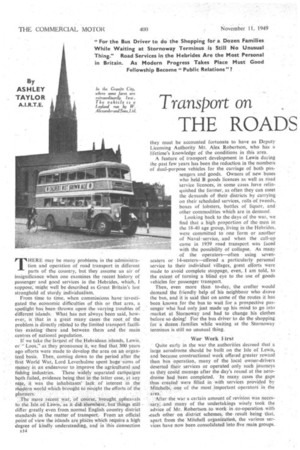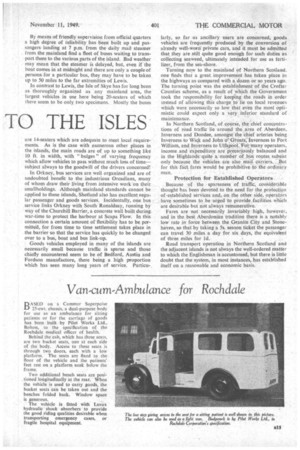Transport on , THE ROADS
Page 104

Page 105

If you've noticed an error in this article please click here to report it so we can fix it.
TO THE ISLES
THERE may be many problems in the administration and operation of road transport in different parts of the country, but they assume an air of insignificance when one examines the recent history of passenger and good services in the Hebrides, which, I suppose, might well be described as Great Britain's last stronghold of sturdy individualism.
From time to time, when commissions have .investigated the economic difficulties of this or that area, a spotlight has beenthrown upon the varying troubles of different islands. What has not always beensaid, however, is that in a great many cases, the root_ of the problem is directly related to the limited transport facilities existing there and between them and the main centres of national population.
If we take the-largest of the Hebridean islands, Lewis, or "Loos," as they pronounce it, we find that 300 years ago efforts were made to develop the area on an organized basis. Then, coming down to the period after the first World War, Lord Leverhulme spent huge sums of money in an endeavour to improve the agricultural and fishing industries. These widely separated campaigns both failed, evidence being that in-the latter case, at any rate, it was the inhabitants' lack of interest in _the Model n world which brought to nought the efforts of the
planners. _. . , .
. The more recent war, 'of course, brought upheavals to the Isle-.of Lewis, as it did elsevvhere, but things still differ greatly even from normal English country district standards in the matter of transport. From an official point of view the islands are places which require a high degree of kindly understanding, and in this connection
0 4
they must be accounted fortunate to have as Deputy Licensing Authority Mr. Alex Robertson, who has a lifetime's knowledge of the conditions in this area.
A feature of transport development in Lewis during the past few years has been the reduction in the numbers of dual-purpose vehicles for the carriage of both passengers and goods. Owners of new buses who held B goods licences as well as road 'service licences, in some cases have quished the former, as often they can meet the demands of their districts by carrying on their scheduled services, rolls of tweeds, boxes of lobsters, bottles of liquor, and other commodities which are in demand.
Looking back to the days of the war, we find that a high proportion of the men in the 18-40 age group, living in the Hebrides. were committed to one form or another of Naval-service, and when the call-up came in 1939 road transport was faced with the possibility of collapse. As many of the operators—often using sevenseaters or 14-seaters—offered a particularly personal service to their individual villages, great efforts were made to avoid complete stoppage, even, I am told, to the extent of turning a blind eye to the use of goods vehicles for passenger transport.
Then, even more than to-day, the crofter would demand the friendly help of his neighbour who drove the bus, and it is said that on some of the routes it has been known for the bus to wait for a prospective passenger who had only just made up his mind to go into market at 'Stornoway and had to change his clothes before so doing! For the bus driver to do the shopping for 'a dozen families while waiting at the Stornoway terminus is still no unusual thing.
War Work First
Quite early in the war the authorities decreed that a large aerodrome should be built on the Isle of Lewis, and because constructional work offered greater reward than bus operation, many of the local owner-drivers deserted their services or operated only such journeys as they could manage after the day's round at the aerodrome had been completed. In many cases the gaps thus created were filled in with services Provided by IVIitchells; one of the most important operators in the area.
After the war a certain amount of revision was nemsary, and many of the undertakings wisely took the advice of Mr. Robertson to work in-co-operation. with each other on district schemes, the result• being that, apart from the Mitchell organization, the various services have now been consolidated Into five main groups. By means of friendly supervision from official quarters a high degree of reliability has been built up and passengers landing at 7 p.m from the daily mail steamer from the mainland find a fleet of buses waiting to transport them to the various parts of the island. Bad weather may mean that the steamer is delayed, but, even if the boat comes in at midnight and there are only a couple of persons for a particular bus, they may have to be taken up to 50 miles to the far extremities of Lewis.
In contrast to Lewis, the Isle of Skye has for long been as thoroughly organized as any mainland area, the largest vehicles in use here being 20-seaters of which there seem to be only two specimens. Mostly the buses
are 14-seaters which are adequate to ifleet local requirements. As is the case with numerous other places in the islands, the main roads are of up to something like 10 ft. in width, with " bulges " of varying frequency which allow vehicles to pass without much lass of time-subject always to the goodwill of the drivers concerned!
In Orkney, bus services are well organized and are of undoubted benefit to the industrious Orcadians, many of whom draw their living from intensive work on their. Smallholdings. Although mainland standards cannot be applied to these islands, Shetland also has excellent regular passenger and goods services. Incidentally, one bus .service links Orkney with South Rorialdsay, running by way of the Churchill Barrier, a concrete wall built during War-time to protect the harbour at Scapa Flow. In this connection a certain amount of flexibility has to be permitted, for from time to time settlement takes place in the barrier so that the service has quickly to be changed over to a bus, boat and bus link-up.
. Goods vehicles employed in many of the islands are necessarily small because traffic is sparse and those chiefly encountered seem to be of Bedford, Austin and Fordson manufacture, there being a high proportion which has seen many long years of service. Particu lady, so far as ancillary users are concerned, goods vehicles are frequently produced by the conversion of already well-worn private cars, and it must be admitted that they are still quite good enough for such duties as collecting seaweed, ultimately intended for use as fertilizer, from the sea-shore.
Turning now to the mainland of Northern Scotland. one finds that a great improvement has taken place in the highways as compared with a dozen or so years ago. The turning point was the establishment of the Crofter Counties scheme, as a result of which the Government took the responsibility for keeping the ilia& in ordeTinstead of allciiving this charge to lie on local revenues which were necessarily so low that even the most optimistic could expect only a very .inferior standard of
maintenance. .
In Northern Scotland, of course, the 'chief concentrations of road traffic lie around the area of Aberdeen, Inverness and Dundee, arnongst'the 'chief arteries being Inverness to Wick and John o"Groats-, Inverness to Fort William, and Inverness to Ullapo—ol."For many operators, income and expenditure are precariously balanced and in the Highlands '• quite a number of bus routes subsist only because the vehicles are also mail carriers, But for this fad. fares 'would be prohibitive to the :ordinary
man. .•
Protection for Established Orators...
Because Because of the sparseness of traffic; considerable thought has been devoted to the need for the protection of,established services and, on the other side, operators have sometimes to be urged to provide facilities Which
are desirable but not always remunerative.
Fares are not necessarily invariably high, however, and in the best Aberdonian tradition there is a notably low rate in force between the Granite City and Stonehaven, so that by taking a 5s. season ticket the passenger can travel 30 miles a day for six days, the equivalent of three miles for Id.
Road transport operation in Northern Scotland and the adjacent islands is not always the well-ordered matter to which the Englishman is accustomed, but there is little doubt that the system, in most instances, has established itself on a reasonable and economic basis.
































































































































































































